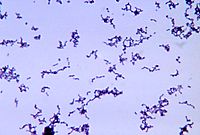
Photo from wikipedia
Background: This study presents the effectiveness of a combined silver carboxylate (AgCar) and chlorohexidine gluconate (AgCar:CHG) chemistry assessed against two commonly encountered nosocomial pathogens, Methicillin-resistant Staphylococcus aureus (MRSA) and Cutibacterium… Click to show full abstract
Background: This study presents the effectiveness of a combined silver carboxylate (AgCar) and chlorohexidine gluconate (AgCar:CHG) chemistry assessed against two commonly encountered nosocomial pathogens, Methicillin-resistant Staphylococcus aureus (MRSA) and Cutibacterium acnes, within the context of surgical antisepsis and wound care. Methods: Through an Institutional Review Board- and Institutional Animal Care and Use Committee (IACUC)-approved protocol, AgCar:CHG was applied to live Yucatan porcine skin and visualized by fast red and green staining to assess level of skin penetration. Dose response curves for Cutibacterium acnes and MRSA were generated to determine the optimal therapeutic ratio of AgCar to CHG. Coatings were applied to two different clinically available sutures and antimicrobial efficacy was evaluated at 24-hour intervals using Kirby-Bauer (KB) assays. Graphite furnace atomic absorption spectroscopy was used to measure AgCar elution from sutures over time. Results: Synergistic application of AgCar:CHG demonstrated deep pilosebaceous gland penetration on Yucatan pig skin. The therapeutic concentration range of AgCar was determined to be between 120 × -150 × and 30 × -60 × dopage for MRSA and Cutibacterium acnes, respectively. A 1:1 therapeutic ratio of AgCar to CHG was found to have 100% bactericidal activity against both pathogens. Sutures coated with AgCar:CHG showed sustained antimicrobial activity against MRSA and Cutibacterium acnes, and were significantly more efficacious than antimicrobial sutures over the three- to four-day period (p < 0.01). Conclusions: This AgCar:CHG chemistry demonstrates deep skin penetration, extended elution, and broad-spectrum antimicrobial activity compared with commercially available options. This chemistry shows promise as an additional tool for the prophylaxis of surgical site infections.
Journal Title: Surgical infections
Year Published: 2022
Link to full text (if available)
Share on Social Media: Sign Up to like & get
recommendations!